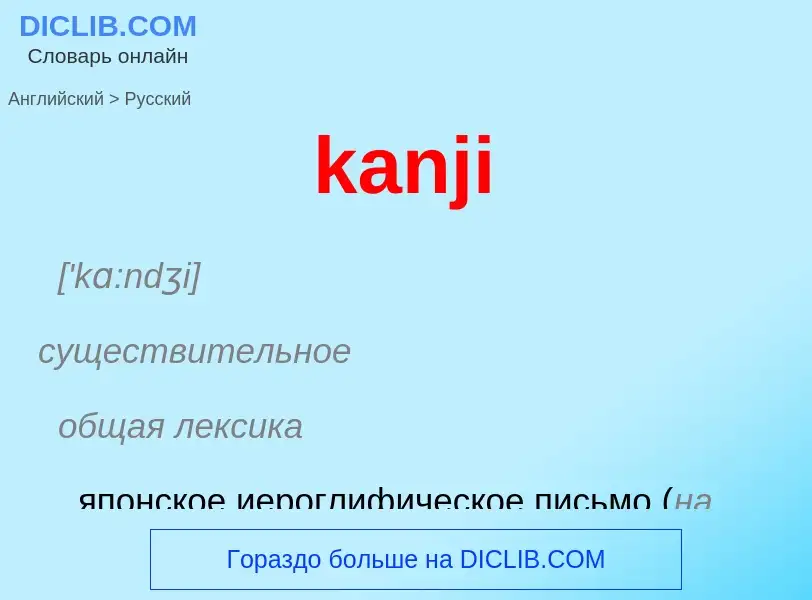Перевод и анализ слов искусственным интеллектом ChatGPT
На этой странице Вы можете получить подробный анализ слова или словосочетания, произведенный с помощью лучшей на сегодняшний день технологии искусственного интеллекта:
- как употребляется слово
- частота употребления
- используется оно чаще в устной или письменной речи
- варианты перевода слова
- примеры употребления (несколько фраз с переводом)
- этимология
kanji - перевод на русский
['kɑ:ndʒi]
существительное
общая лексика
японское иероглифическое письмо (на основе китайской иероглифики)
общая лексика
китайские иероглифы
Определение
Википедия
Kanji (漢字, pronounced [kaɲdʑi] (listen)) are the logographic Chinese characters taken from the Chinese script, and used in the writing of Japanese. They were made a major part of the Japanese writing system during the time of Old Japanese and are still used, along with the subsequently-derived syllabic scripts of hiragana and katakana. The characters have Japanese pronunciations; most have two, with one based on the Chinese sound. A few characters were invented in Japan by constructing character components derived from other Chinese characters. After World War II, Japan made its own efforts to simplify the characters, now known as shinjitai, by a process similar to China's simplification efforts, with the intention to increase literacy among the common folk. Since the 1920s, the Japanese government has published character lists periodically to help direct the education of its citizenry through the myriad Chinese characters that exist. There are nearly 3,000 kanji used in Japanese names and in common communication.
The term kanji in Japanese literally means "Han characters". It is written in Japanese by using the same characters as in traditional Chinese, and both refer to the character writing system known in Chinese as hanzi (traditional Chinese: 漢字; simplified Chinese: 汉字; pinyin: hànzì; lit. 'Han characters'). The significant use of Chinese characters in Japan first began to take hold around the 5th century AD and has since had a profound influence in shaping Japanese culture, language, literature, history, and records. Inkstone artifacts at archaeological sites dating back to the earlier Yayoi period were also found to contain Chinese characters.
Although some characters, as used in Japanese and Chinese, have similar meanings and pronunciations, others have meanings or pronunciations that are unique to one language or the other. For example, 誠 means 'honest' in both languages but is pronounced makoto or sei in Japanese, and chéng in Standard Mandarin Chinese. Individual kanji characters invented in Japan, or multi-kanji words coined in Japanese, have also influenced and been borrowed into Chinese, Korean, and Vietnamese in recent times. For example, the word for telephone, 電話 denwa in Japanese, is calqued as diànhuà in Mandarin Chinese, điện thoại in Vietnamese and 전화 jeonhwa in Korean.


![''[[Nihon Shoki]]'' (720 AD), considered by historians and archaeologists as the most complete extant historical record of ancient Japan, was written entirely in kanji. ''[[Nihon Shoki]]'' (720 AD), considered by historians and archaeologists as the most complete extant historical record of ancient Japan, was written entirely in kanji.](https://commons.wikimedia.org/wiki/Special:FilePath/Nihonshoki tanaka version.jpg?width=200)
![Yōshū Chikanobu]], 1897. Yōshū Chikanobu]], 1897.](https://commons.wikimedia.org/wiki/Special:FilePath/Yōshū Chikanobu Shin Bijin No. 20.jpg?width=200)





![Yellow}}: Chinese characters were once used officially, but this is now obsolete ([[Mongolia]], [[North Korea]], [[Vietnam]]) Yellow}}: Chinese characters were once used officially, but this is now obsolete ([[Mongolia]], [[North Korea]], [[Vietnam]])](https://commons.wikimedia.org/wiki/Special:FilePath/Map-Chinese Characters.png?width=200)

![Mongolian text from ''[[The Secret History of the Mongols]]'' in Chinese transcription, with a glossary on the right of each row Mongolian text from ''[[The Secret History of the Mongols]]'' in Chinese transcription, with a glossary on the right of each row](https://commons.wikimedia.org/wiki/Special:FilePath/Secret history.jpg?width=200)

![Mifu]]. For centuries, the Chinese literati were expected to master the art of calligraphy. Mifu]]. For centuries, the Chinese literati were expected to master the art of calligraphy.](https://commons.wikimedia.org/wiki/Special:FilePath/This Letter written by Mi Fei.jpg?width=200)
![Sample of the cursive script by Chinese [[Tang dynasty]] calligrapher [[Sun Guoting]], c. 650 AD Sample of the cursive script by Chinese [[Tang dynasty]] calligrapher [[Sun Guoting]], c. 650 AD](https://commons.wikimedia.org/wiki/Special:FilePath/Treatise On Calligraphy.jpg?width=200)

![A page from a [[Song dynasty]] publication in a [[regular script]] typeface which resembles the handwriting of [[Ouyang Xun]] from Tang Dynasty A page from a [[Song dynasty]] publication in a [[regular script]] typeface which resembles the handwriting of [[Ouyang Xun]] from Tang Dynasty](https://commons.wikimedia.org/wiki/Special:FilePath/浙江姓解1.jpeg?width=200)
